Common menu bar links
Balance of international payments
Archived Content
Information identified as archived is provided for reference, research or recordkeeping purposes. It is not subject to the Government of Canada Web Standards and has not been altered or updated since it was archived. Please "contact us" to request a format other than those available.
First quarter 2008
Balance of international payments note to readers
Highlights
The current account surplus with the rest of the world (on a seasonally adjusted basis) increased sharply to $5.6 billion in the first quarter of 2008, led by higher prices for several exported commodities combined with a lower travel deficit. The deficits on commercial services and investment income were largely unchanged.
Chart D.1
Large increase of the current account surplus
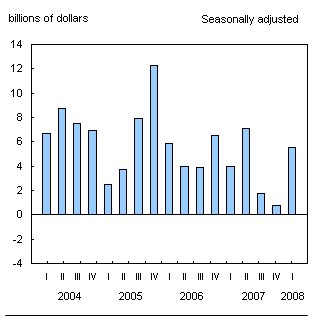
In the capital and financial account (not seasonally adjusted), foreign direct investment flows into Canada slowed significantly from the acquisitions-driven pace of the previous quarter, while Canadian direct investment abroad continued to strengthen. Canadian portfolio investors focussed on foreign equities, while their non-resident counterparts’ investment flows were dominated by federal bonds.
Goods surplus strengthens
The goods surplus widened to $13.4 billion during the first quarter, up strongly from the previous two quarters. Much of the increase came from gains on the export side that were again dominated by the growth in the value of exports of energy products.
Chart D.2
Goods surplus improves as exports rebound
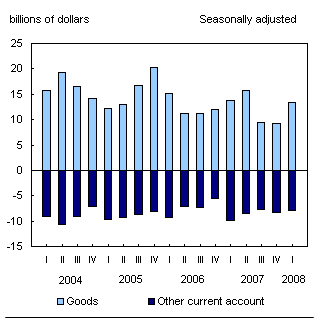
Exports of goods reached $116.7 billion in the first quarter, growing 5% from the previous quarter. With price gains in excess of 20% in the first quarter, export values of crude petroleum plus natural gas advanced sharply. Higher prices were also important factors in higher exports of industrial goods, notably precious metals and alloys. and of agricultural products on record sales of wheat and canola. Exports of automotive products declined for the fourth consecutive quarter, reaching their lowest levels since the end of 1996.
Chart D.3
High prices push exports of energy products to a record level
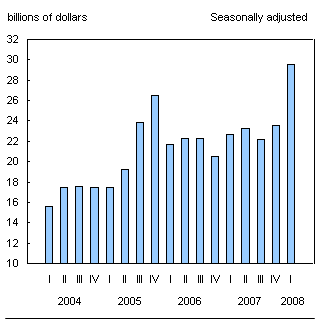
Imports were up $1.4 billion in the first quarter largely reflecting higher volumes and prices for energy products. However, these gains were partially offset by lower imports of automotive products.
Services deficit narrows modestly
Following a substantial increase in the fourth quarter of 2007 the services deficit narrowed slightly in the first quarter, led by travel.
After a record high in the fourth quarter, the expenditures of Canadian travellers going to the United States dropped this quarter as fewer Canadians crossed the borders for both same-day and longer trips. The travel deficit with overseas countries widened while that with the United States was reduced. Nevertheless, the travel deficit with the U.S. was the second largest on record at $2.2 billion. Chart D.4
Canadians reduce their spending in United States and travel
deficit shrinks
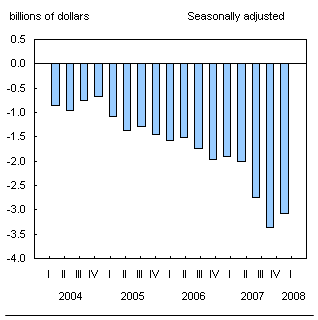
The deficit on investment income remains steady
During the first quarter of 2008, the investment income deficit was marginally reduced by $0.2 billion. The deficit on income from portfolio securities continued to narrow, while profits earned by operations of Canadian direct investors abroad declined by less than the reduction in net earnings of foreign direct investors on their investment in Canada.
Canadian direct investment abroad surpasses inward direct investment flows
Inflows into the Canadian economy by foreign direct investors slowed considerably in the first quarter while Canadian direct investment into foreign economies picked up speed. The resulting $5.1 billion net direct investment outflow was the first net outflow since the second quarter of 2006.
With the dollar losing some ground against its U.S. counterpart but still remaining near parity, Canadian direct investors made sizable acquisitions of foreign firms ($11.7 billion) in the quarter, mainly in the finance and insurance sector. They also injected significant funds into existing foreign affiliates ($10.5 billion).
Chart D.5
Canadian direct investment abroad continues
to strengthen1
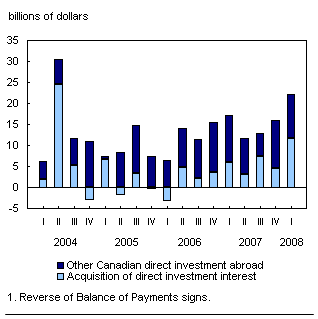
On the other hand, the acquisitions-driven pace of foreign direct investment in Canada at the time of the fourth quarter of 2007 was not sustained. The slowdown also reflected much reduced investment activity in the Canadian resource-based sector, compared with the last few quarters. The overall direct investment inflow of $17.2 billion, while still significant, was the lowest level in close to two years.
Chart D.6
Drop in acquisitions activity leads to lower
foreign direct investment in Canada
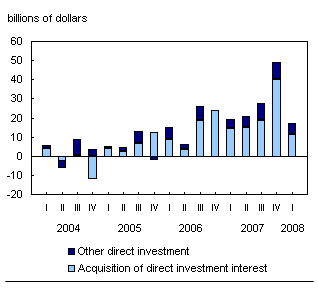
Canadian bonds attract foreign investors
Non-resident investors purchased $9.9 billion worth of Canadian securities over the first quarter, following three consecutive quarters of divestment. The bulk of the quarter’s foreign investment occurred in outstanding Canadian-dollar denominated bonds, in the context of a higher inflation reading and declining bond yields in the U.S. They also acquired Canadian equities ($3.7 billion), coinciding with a 3.5% drop in stock prices.
Non-residents were especially active in bonds of the federal government and its enterprises, which offer low credit and liquidity risks. This was in contrast to foreign activity in the Canadian money market, which produced a $3.5 billion divestment. Canadian short-term rates were sharply reduced in the first quarter, making long term debt instruments relatively more attractive.
Chart D.7
Non-resident investors favour government bonds
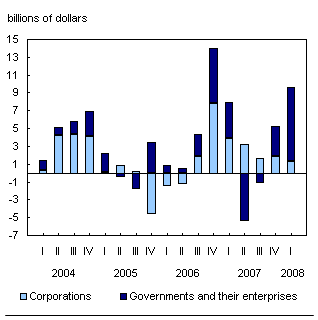
Canadian investors continue to shy away from foreign debt instruments
Canadian investors were less focussed on foreign securities in the first quarter of 2008. They purchased $3.3 billion worth of foreign securities, mainly equities. Purchases of foreign shares were substantially weaker than previous periods, reflecting a general softening in global stock prices over the quarter.
Chart D.8
Canadian investors acquire foreign stocks
at a slower pace1
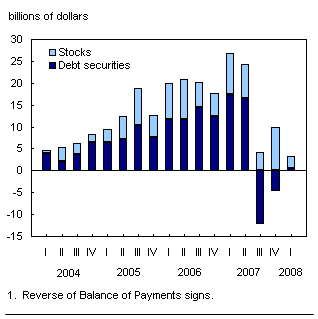
Residents were net buyers of foreign bonds after two quarters of sizeable divestments, but activity was very modest in light of the record purchases over the first half of 2007. This was reflected in the scarcity of new issues of maple bonds. The appreciating Canadian dollar, combined with the recent credit crunch, contributed to increased costs related to the issue of new maple bonds. At the same time, Canadians turned to more secure investment vehicles, placing substantial funds in deposit-assets.
Data tables
Information on methods and data quality available in the Integrated Meta Data Base: 1534, 1535 and 1536.

